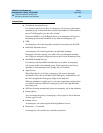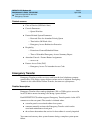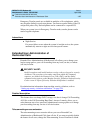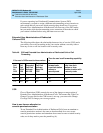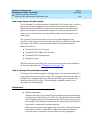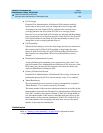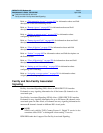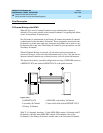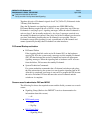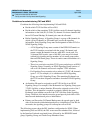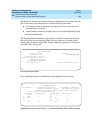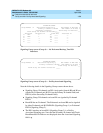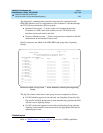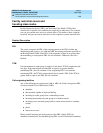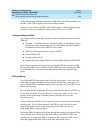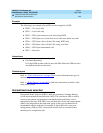
DEFINITY ECS Release 8.2
Administrator’s Guide
555-233-506
Issue 1
April 2000
Features and technical reference
1333Facility and Non-Facility Associated Signaling
20
Together, this pair of D-channels signals for all 70 (23+24+23) B-channels in the
3 Primary Rate Interfaces.
Since the D-channels are signaling for more than one ISDN-PRI facility,
D-Channel Backup requires the use of NFAS. At any given time, one of the two
D-channels is carrying Layer 3 signaling messages, while the other D-channel is
active at layer 2, but in standby mode only. Any layer 3 messages received over
the standby D-channel are ignored. Since only one of the D-channels can be active
at a time, load sharing between the two D-channels is not possible. The two
D-channels can provide signaling for only a predefined set of B-channels and
cannot dynamically backup other D-channels on other interfaces.
D-Channel Backup activation
■ D-Channel Failure
If the signaling link fails on the active D-channel (D1) or the hardware
carrying D1 fails, the system sends a message over the standby D-channel
(D2). D2 then becomes the active D-channel and carries all subsequent
signaling messages. When the signaling link or hardware on D1 recovers
from the failure, D1 becomes the standby D-channel.
■ System Technician Commands
If a system technician commands that a D-channel switchover take place,
the first action taken by the system is to tear down the signaling link on D1.
After this is completed, a message is sent on D2 to request that D2 become
the active D-channel. D2 then becomes the active D-channel and the
switchover is complete.
Screens used to administer FAS and NFAS
The following list shows the required screens and the fields you must use on each
screen:
■ Signaling Group (Refer to the DEFINTY services documentation for
information about this screen.)
—all
■ ISDN trunk group
—Port
—Sig Grp
■ DS1 Circuit Pack
— Signaling Mode



